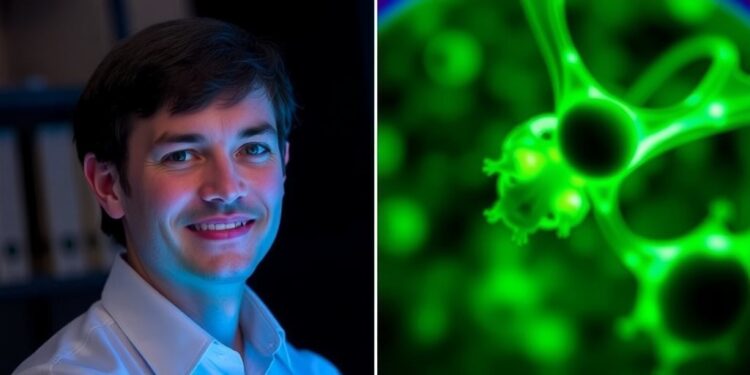
In a groundbreaking study that bridges the gap between physics and biological science, researchers at Michigan State University have made significant strides in understanding the dynamics of viruses through a novel technique referred to as BioSonic spectroscopy. This innovative method utilizes the principles of ultrafast spectroscopy, where laser pulses are employed not merely to visualize but to “listen” to the vibrational frequencies emitted by viruses. This research not only provides fresh insights into viral behavior but also sets the stage for potential applications in disease detection and medical interventions.
The research led by Elad Harel, an associate professor of chemistry at MSU, has revealed that viruses, much like other biological entities, possess unique vibrational signatures akin to sound. These signatures result from the collective motion of atoms within a virus, creating a distinct frequency that can be measured and analyzed. By using short laser pulses, the team was able to induce coherent vibrations in the virus particles, effectively allowing them to eavesdrop on molecular movements. This auditory approach to biological systems is revolutionary, as it adds a new dimension to how scientists study pathogens.
One of the primary motivations behind this research is the inherent limitations of traditional imaging techniques, such as electron microscopy. While EM provides detailed snapshots of viral structures, it often operates under conditions that are not representative of the virus’s natural environment. By contrast, BioSonic spectroscopy seeks to observe viruses in a “hot and wet” environment that closely mimics their biological context. This approach not only enhances the accuracy of observations but also significantly augments the temporal resolution, providing real-time insights into viral dynamics.
In this recent study, featured in the esteemed Proceedings of the National Academy of Sciences, the research team detailed how they manage to “listen” to the sounds of a virus. As they fired laser pulses at viral samples, the interactions facilitated vibrations that echoed in the gigahertz frequency range. Interestingly, it was discovered that the vibrational patterns changed in response to the structural integrity of the virus. As the virus began to rupture, the acoustic signature altered, resembling the deflation of a balloon. Such findings open up exciting avenues for further investigation into viral behavior, potentially transforming the field of virology.
Collaboration played a vital role in the success of this research. Harel’s team partnered with experts from the Department of Microbiology, Genetics, and Immunology, particularly Dohun Pyeon. This interdisciplinary approach has allowed for a deeper understanding of viral properties and provided invaluable resources for viral targets. According to Yaqing Zhang, a postdoctoral researcher and the study’s first author, the ability to observe nanoscale motions of viruses is pioneering. The insight gained from these experimental observations could potentially lead to greater preparedness against future pandemics.
The broader implications of BioSonic spectroscopy are manifold. Beyond simply understanding viruses, this technique could serve as a crucial tool in accelerating drug development and antiviral research. By observing live viral life cycles, researchers can investigate how various interventions impact viral behavior, thereby expediting the discovery of effective treatments. This could prove critical in an age where emerging viral threats pose substantial challenges to global health.
Furthermore, the unique ultrasonic signatures of various biological entities suggest potential applications beyond virology. Understanding the vibrational dynamics of proteins, bacteria, and even cellular components could yield transformative knowledge across multiple fields within life sciences. This research inherently blurs the lines between disciplines, promoting an integrative approach that may redefine our understanding of molecular interactions.
Looking ahead, the research team is excited about future investigations that could take this work a step further. They hope to develop methodologies to dynamically track viral movements in real time and explore how these behaviors change when viruses interact with various biological agents. It is also anticipated that as this technique matures, it could become prevalent in labs worldwide, offering a fresh perspective on biological research.
Such scientific endeavors not only excite the academic community but also hold the promise of real-world applications that could change the future of infectious disease management. The ability to observe viral behavior as it happens, rather than relying on static images, represents a substantial leap forward in our approach to studying deadly pathogens. This might lead to advanced diagnostics that allow for quicker treatment responses during viral outbreaks, ultimately saving lives.
In conclusion, the work carried out by Elad Harel and his collaborators represents a significant advancement in the realm of bioimaging and molecular dynamics. The application of sound to study viruses not only enhances our comprehension of these microscopic entities but also heralds a new era of biomedical research focused on real-time observation and analysis. This innovative methodology has the potential to revolutionize the way we study not just viruses but various biological systems, opening the door to an exciting frontier in science.
Subject of Research: BioSonic spectroscopy in virology
Article Title: Nanoscopic acoustic vibrational dynamics of a single virus captured by ultrafast spectroscopy
News Publication Date: 21-Jan-2025
Web References:
References:
Image Credits:
Keywords: Virology, Ultrafast Spectroscopy, BioSonic Spectroscopy, Viral Dynamics, Acoustic Imaging
Tags: auditory analysis of pathogensbiological insights through physicsBioSonic spectroscopyElad Harel chemistry researchinnovative disease detection methodslight-based hearing methodsmedical intervention applicationsMichigan State University researchmolecular vibrations in virusesultrafast spectroscopy techniquesunique vibrational signaturesviral behavior analysis





